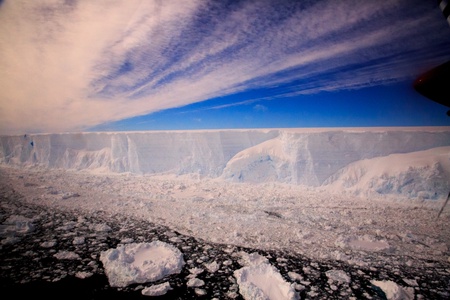A team of scientists, led by British Antarctic Survey (BAS), heads to Antarctica this week (14 February) to investigate a mysterious marine ecosystem that's been hidden beneath an Antarctic ice shelf for up to 120,000 years.
The iceberg known as A68, which is four times of London, calved off from the Larsen Ice Shelf in July 2017. The scientists will travel by ship to collect samples from the newly exposed seabed, which covers an area of around 5,818 km2. It is an urgent mission. The ecosystem that has likely been hidden beneath the ice for thousands of years may change as sunlight starts to alter the surface layers of the sea.
The international team, from nine research institutes including the University of Aberdeen, leaves Stanley in the Falkland Islands on 21 February to spend 3 weeks in February-March 2018 on board the BAS research ship RRS James Clark Ross. Satellite monitoring is critical for the ship to navigate through the ice-infested waters to reach this remote location.
Marine biologist Dr Katrin Linse from British Antarctic Survey is leading the mission. She says:
“The calving of A68 provides us with a unique opportunity study marine life as it responds to a dramatic environmental change. It’s important we get there quickly before the undersea environment changes as sunlight enters the water and new species begin to colonise. We’ve put together a team with a wide range of scientific skills so that we can collect as much information as possible in a short time. It’s very exciting.”
The team will investigate the area previously under the ice shelf by collecting seafloor animals, microbes, plankton, sediments and water samples using a range of equipment including video cameras and a special sledge pulled along the seafloor to collect tiny animals. They will also record any marine mammals and birds that might have moved into the area. Their findings will provide a picture of what life under the ice shelf was like so changes to the ecosystem can be tracked.
This newly exposed marine area is the first to benefit from an international agreement made in 2016 by the Commission for the Conservation of Antarctic Marine Living Resources (CCAMLR). This agreement designates Special Areas for Scientific Study in newly exposed marine areas following the collapse or retreat of ice shelves across the Antarctic Peninsula region. The agreement came following a European Union proposal to CCAMLR, led by British Antarctic Survey (BAS) scientists.
Professor Ursula Witte, who is the Aberdeen lead on the project, commented: “The Aberdeen team are looking at what we call ‘ecosystem functioning’. We determine how much food the ecosystem at the seafloor currently consumes, and carry out experiments using tracers and biomarkers to reconstruct the food web at the site, and the flow of nutrients through this food web.
“Getting in so early after the calving event is very exciting because it will allow us to see how deep-sea ecosystems adapt to rapid change, and how an oligotrophic community ( a community adapted to coping with very little food) transitions when suddenly presented with significantly more food.”
Dr Anni Mäkelä, who is part of the research team, added: “I am very excited to participate on this once-in-a-lifetime cruise and investigate this previously unexplored ecosystem. It’s a great privilege to take part and hopefully our work will enable us to answer some fundamental ecological questions about the flow of nutrients in this previously hidden seafloor ecosystem.
Kirsten Macsween, a PhD student working on the project said: “I am thrilled to have the unique opportunity to take part in an expedition such as this so early in my career that will allow us to investigate previously unexplored territory.”


